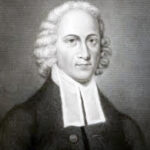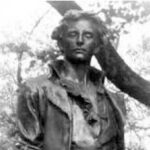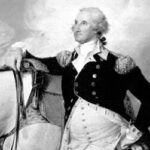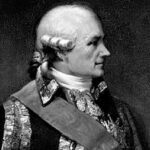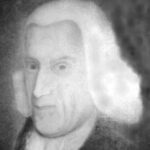by Hans DePold, town historian
(Published in the Bolton Community News, February 2004; Revised September 2013)
The Washington-Rochambeau Revolutionary Route (W3R©) National Historic Trail (NHT) is now a reality. Special thanks go to Bolton State Representative Pamela Sawyer, whose legislation to document the history of the Washington-Rochambeau Revolutionary Road in Connecticut passed in 1998. Special thanks also go to Congressman John Larson and Senator Joseph Lieberman, who introduced the W3R© NHT study bill in 2000. Every Congressman along the W3R© co-sponsored the bill. The route follows Bolton Center Road from Manchester, then Brandy Street, and then Bailey Road to Andover.
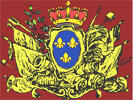 Expédition Particulière was the name of the French expedition of allied troops sent to assist our new American nation in the War of Independence. The symbol of the expedition was carried on the march. Bolton is painted with Revolutionary War heritage. There are dabs of white houses, splotches of red barns, and pastel green fields where soldiers camped on their marches.
Expédition Particulière was the name of the French expedition of allied troops sent to assist our new American nation in the War of Independence. The symbol of the expedition was carried on the march. Bolton is painted with Revolutionary War heritage. There are dabs of white houses, splotches of red barns, and pastel green fields where soldiers camped on their marches.
Flags That Flew in Bolton

This was the personal flag of the Commander-in-Chief during the Revolutionary War.

Commanded by Comte de Saint Maisme. Second in command was Vicomte de Noailles, brother-in-law to Lafayette. Vicomte de Noailles led the 16 Oct charge that recaptured two French redoubts. The regimental uniform was white with red trim.
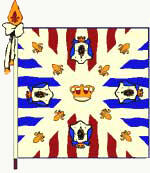
Commanded by Comte Christian de Forbach de Deux-Ponts. The regimental uniform was deep sky blue with yellow trim. The hat was black with the three alliance cockades.
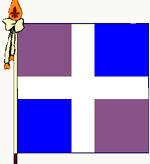
Commanded by Marquis de Laval de Montmorency. Second in command was Vicomte de Rochambeau, son of Comte de Rochambeau. The regimental uniform was white with black trim.

Usually with a large white cross stitched in outline. There were usually three large gold fleurs-de-lis in the upper left canton. The French army used the white Greek cross since the time of the Crusades.
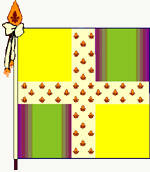
The second battalion that accompanied the four line regiments that marched with Rochambeau in 1781 and 1782. French artillerymen's uniforms were dark blue with red trim.
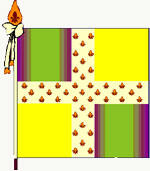
The Royal Metz artillery accompanied the four line regiments that marched with Rochambeau. Its commander, Comte d'Abouville, commanded all the French artillery at Yorktown.
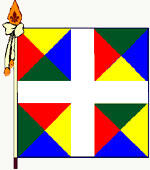
Commanded by Comte de Custine. The regimental uniform was white with green trim. They wore a black tricornered hat with three cockades symbolizing the Alliance.

The Betsy Ross flag was the first official U.S. flag recognized internationally. It was approved by congressional action June 14, 1777.

Wintered in Lebanon, Conn. When it was time to march, Lauzun's legion took the left flank of the army to prevent any surprise attacks from the British.
Bolton's Historic Visitors
- 1634 Trader John Oldham and three companions were the first English men to set foot in Bolton as they made their way on what would become known as the Old Connecticut Path. (SHPO report 1998)
- 1636 Reverend Thomas Hooker led Puritan followers from Massachusetts through Bolton then on the Old Connecticut Path to settle in Hartford, becoming the first settlement in Connecticut. (SHPO report 1998)
- 1644 The mighty Mohegan sachem Uncas traveled through Bolton to the Hartford colony with a great number of his bravest warriors and most trusted advisors. The American Indians made the first encampments in Bolton. (Bib 10)
- 1675 Mohegan Chief Joshua granted land to Major Talcott. (Col. Rec. Lands, iv. 334) Bolton was in the more northerly and westerly of these two tracts. (Bolton History)
- Rev. Jonathan Edwards is credited with igniting the First Great Awakening in America. He later wrote that he had his epiphany walking through the fields of Bolton in the summer of 1724, at age 21. In November of that year he signed on as Bolton's first pastor, a position he held until May 1725. (Bib 16)
- 1753 & 1763 The British Crown's postmaster, Benjamin Franklin, reported he inspected the New England post roads and had markers installed. At that time the post road went up what is now Bailey Road and through Bolton on Center Street. (Bib 11 pgs. 160, 164)
- 1769 Nathan Hale began his studies at Yale. The family passed through Bolton several times on route to New Haven.
- "Rebel Governor" Jonathan Trumbull lived in Lebanon and traveled to the Capital in Hartford on the Hartford Road through Bolton.
- April 1775 Captain Jonathan Birge and 60 other minutemen from Bolton, joined by 45 men from Hartford, rode out to participate in the Lexington Alarm.
- October 18, 1776 (Friday) Continental Army troops breakfasted in Bolton on their way to the Quebec Campaign. (Bib 4 pg. 33)
- April 12, 1777 Continental Army troops camped in Bolton, on a Saturday in rain and cold, on their way to the Delaware Defense. (Bib 4 pg. 71)
- January 29, 1778 (Thursday) Continental Army troops from Valley Forge rested in Bolton on their way to study British positions in Rhode Island. (Bib 4 pg. 110)
- May 12, 1778 (Tuesday) Continental Army troops stopped and oated horses in Bolton on their way to Valley Forge. (Bib 4 pg. 117)
- July 28, 1778 (Tuesday) A troop movement of the Continental Army (about 1,000 men) stopped in Bolton and cooked up lunch on their way to the Battle of Rhode Island. Brig. General James Mitchell Varnum led his brigade plus Col. Henry Jackson's regiment. (Bib 4 pg. 125 & Bib 6)
- November 21, 1779 (Sunday evening) Victorious Continental Army troops returning from Rhode Island had dinner in Bolton and camped the night on their way to Valley Forge. (Bib 4 pg. 144)
- May 4, 1780 The Hon. Major General the Marquis de Lafayette returned from France and passed from Boston through Bolton to Hartford to Morristown. With him was M. de Gimat. (Bib 5 & 6)
- July 22, 1780 The Hon. Major General the Marquis de Lafayette passed through Bolton going from Hartford to Lebanon to Newport, to greet the newly arrived General Rochambeau. (Bib 5 & 6)
- September 20, 1780 (Wednesday) Rochambeau and Chastellux made a round trip through Bolton during their trip to the Hartford Conference. They may have stayed at the White Tavern on Brandy Street in Bolton. (Bib 17 pg. 16)
- November 16, 1780 (Thursday) Chastellux, a major general under Rochambeau, an enlightened man, a member of the French Academy, and a perceptive observer of affairs in the new republic wrote: "After descending a gentile [sic] slope for about two miles, I found myself in a rather narrow, but agreeable and well-cultivated valley: it is watered by a rivulet which flows into the 'Sheunganick' and which is adorned with the name of 'Hope' River; you follow this valley to Bolton." (Bib 13 Pg. 72) All maps prior to 1811 show the current Hop River had been called the "Hope" River.
- November 16, 1780 (Thursday) The Duc de Lauzun rode with some of his men through Bolton to Hartford and passed General Chastellux. (Bib 13 Pg. 73)
- December 23, 1780 (Saturday) Continental Army troops stopped in Bolton on the way to Rhode Island to meet the French. (Bib 4 pg. 189)
- January 11, 1781 (Thursday) General Knox, the American artillery commander, rode through Bolton on the W3R© NHT to Lebanon to tell the French that the Pennsylvania and New Jersey brigades had mutinied. (Bib 12 pg. 194)
- February 15, 1781 (Thursday) Major General the Marquis de Lafayette passed through Bolton on his trip from Providence to Lebanon to Hartford, checking the precise route and the campsites before the march of Rochambeau. (Bib 5 & 6)
- March 4, 1781 (Sunday) General George Washington, accompanied by Alexander Hamilton and protected by dragoons, dined at the home of Reverend George Colton, now the site of Heritage Farm in Bolton. (Bib 8) French General Von Closen preceded Washington by one day announcing his coming.
- March 27, 1781 (Tuesday) Continental Army troops stopped in Bolton after seeing Washington review Rochambeau's French troops in Newport, RI. (Bib 4 pg. 205)
- Starting Monday, May 21-22, 1781 Rochambeau and Chastellux made a round trip through Bolton during their trip to the Wethersfield Conference. Rochambeau stayed in Andover at the Daniel White Tavern and passed through Bolton. (Bib 1 note 17 on pg. 25)
- June 21-24, 1781 Four French regiments of 1,000+ men each, under General Rochambeau, camped on Minister's Farm (now called Heritage Farm) in Bolton. General Rochambeau was the guest that night of Reverend Colton. (Bib 1 pg. 25)Lieutenant Gabriel-Gaspard Baron de Gallatin of the Deux Ponts Régiment relates that in Bolton, "the band played outside the camp and we danced on the green." (Bib 1)Louis-Alexandre Berthier's itinerary says, "When within 4 miles of Bolton, you begin to encounter more houses. The road is then very close to the river. You cross a brook on a wooden bridge. There is a ford beside it and a sawmill on the left, then. Beyond the bridge turn left, then go through a small hamlet of scattered houses separated by several little brooks that flow down to the river. You leave on the left Parton's house, or White's Tavern (Hutchinson Road, Andover). You cross a few more brooklets. You go through a little wood where the road climbs sharply. This grade is very steep (Bailey Road). At the top you turn sharp right and come to the first houses of Bolton. Bolton is a small town comprising many scattered houses, some of which are clustered around the meetinghouse on a spacious but low plateau. Through this part of Bolton runs a high road that goes left to Colchester and right to Boston. The Camp is to be located on this (east) side of the meetinghouse." (Bib 14)
Clermont-Crevecoeur 21 June 1781 notes after traveling through Bolton, "Bolton, a very small town, which is quite pretty. The roads were frightful, with mountains and very steep grades... We had entered the providence of Connecticut, one of the most productive in cattle, wheat, and every kind of commodity. It is unquestionably the most fertile province in America, for its soil yields everything necessary to life. The pasture is so good here that the cattle are of truly excellent quality. The beef is exceptionally good. The poultry and game are exquisite."
Clermont-Crevecoeur 22 June 1781 from Bolton to Hartford, "This country has a very healthy and salubrious climate. We have seen old people here of both sexes who enjoy perfect health at a very advanced age. Their old age is gay and amiable, and not at all burdened with the infirmities that are our lot in our declining years. The people of this province are very hardworking, but they do not labor to excess, as our peasants do. They cultivate only for their physical needs. The sweat of their brow is not expended on satisfying the extravagant desires of the rich and luxury loving; they limit themselves to enjoying what is truly necessary. Foreigners are cordially welcomed by these good people. You find a whole family bustling about to make you happy. Such are the general characteristics of the people of Connecticut."
- December 7, 1781 (Friday) The Hon. Major General the Marquis de Lafayette passed through Bolton on a trip from Philadelphia to Hartford to Boston. The Hartford Courant reported the trip four days later. (Bib 5 & 6)
- November 4, 1782 Yale President Ezra Stiles visited with General Rochambeau at the home of Reverend George Colton, now the site of Heritage Farm in Bolton. Stiles and Rochambeau conversed in Latin. Rochambeau finished his report on the French involvement in the American Revolution and posted it from Bolton to George Washington. Washington responded to Rochambeau's letter, mentioning Bolton, and saying he had sent Rochambeau's report on to the French representatives. It is probable that Rochambeau also spent that night at the farm as he had in 1781. The French army stayed at Camp 46, which extended on both sides of Bailey and Hutchinson Roads in what is now Andover where Route 6 intersects them. (Bib 1 pg. 190)
- October 13, 1784 The Hon. Major General the Marquis de Lafayette passed through from Albany to Hartford to Boston. (Bib 5 & 6)
- November 9, 1789 President George Washington rode through the Bolton Notch and on to Manchester. This was part of his first presidential trip to New England. (Bib 8)
When Route 6 was designated a national highway in 1913, it bypassed Bolton Center and for the first time the road went through the notch. That saved Bolton's center. The discovery of uniform buttons from the Continental Army and Rochambeau's army, and cannon and musket balls, has helped raise awareness of the importance of preserving the historic route and Camp 5 (Heritage Farm).
Bolton's Heritage Farm is not just a beautiful centerpiece for Bolton, but also a historic vista. As we come down Brandy Road to the farm we see the same view today that Rochambeau and Washington saw in 1781. On the farm itself we find an original colonial road lined with stone walls leading to a circular stone corral that was for lost-and-found animals of the community. Nearby is a spring in the shade of a linden tree and a grove of six ancient oak trees planted before the birth of America.

Methodology & Sources of Information
The first paths through Bolton were those of the American Indians, the Mohegans. The early settlers used the native paths. The roads at the time of the American Revolution were passable by horse but very difficult for wagons. The postal service of the Crown of England was the major user of the road. The road from Boston to Hartford was known as the Middle Post Road and it was the fastest route between Boston and New York City. The earliest evidence is that the Middle Post Road and the road to Providence entered Bolton together until at least the beginning of the Revolution.
The Post Road was continually improved and by 1781 the French maps show it was relocated to the west side of Heritage Farm (abandoned Stony Road) and joined the Providence road at the center of Bolton, forming the corner of Heritage Farm (French Camp 5). These roads remained at that location until the turnpikes were built circa 1795. The evidence is that everyone traveling between Hartford and Boston or Providence on the fastest routes passed through Bolton and past Heritage Farm up until about 1795. Many of the patriots passing the farm are now identified but many more need to be researched.
Knowing each of the few roads that were available, it becomes a matter of verifying who used the road and then determining the dates they were in Bolton. Some of the patriots' diaries and itineraries like Washington's are precise, tell what they did in Bolton, and sometimes give the weather conditions. Others, such as Lafayette's letters, leave evidence of when they were in adjacent towns. Lafayette may say he writes from Farmington that he will be in Lebanon in two days and the letter is posted in Hartford the next day. In that case we compute that at his rate of travel he passed through Bolton about midday of the day he said he would arrive at Lebanon. It is a matter of research to collect the evidence.
Lafayette (Bib 5) allows us to calculate the days when he passed through Bolton. Lafayette (Bib 6) allows us to verify his days in Bolton and that he inspected the planned camps on Rochambeau's route (like Heritage Farm). Lafayette does not post any letters in Bolton nor does he write specifically about Bolton. However, from his route and the dates in Hartford, Lebanon, Providence, and Boston, and from his plans and speed of travel, the date in Bolton is computable within one day. Evidence indicates five trips definitely went through Bolton.
Some visitors such as Benjamin Franklin are much less precise. As postmaster for the Crown of England in 1753 and 1763 he reports he personally inspected the Post Roads in the later part of those years. The days he passed through Bolton are not yet determined with sufficient evidence. Nathan Hale passed the farm traveling to and from Yale and later when he joined the Knowlton Rangers and became an American spy. Eventually letters, Yale records, or diaries may be found to make precise those dates.
The diary of Jeremiah Greenman (Bib 4) provides a day-to-day account of the Continental Army units he served. It provides the time of day they were in Bolton on five occasions and describes their activities in town.
The itinerary of Washington (Bib 8) provides the date and time Washington was in Bolton and provides some details about Reverend Colton that indicate they had intimate conversations in Bolton.
Lafayette's letters also give the travel plans of other generals. For instance, he places General Varnum in Hartford traveling toward Providence. Two days later Private Greenman's diary corroborates Lafayette's letter one rainy afternoon in Bolton.
Bibliography
- Crevecour, Jean Francois Louis, and others. American Campaigns of Rochambeau's Army. Translated and edited by Howard C. Rice Jr. and Anne S. K. Brown.
- Smith, Donald. "When French Money Changed Bolton Highway To Silver Lane." from The Hartford Courant, December 22, 1940, reprinted in Bolton's Heritage by Bruce Ronson.
- Whitridge, Arnold. Rochambeau. New York: The Macmillan Company, 1965.
- Greenman, Jeremiah. Diary of a Common Soldier in the American Revolution, 1775-1783. Edited by Bray, Robert and Bushnell.
- Nolan, J. Bennett. Lafayette in America Day by Day. Baltimore: Johns Hopkins Press, 1934.
- Idzerda, Stanley J. Lafayette in the Age of the American Revolution. Cornell University Press, 1977.
- Forbes, Allan and Paul Cadman. France and New England. State Street Trust Company of Boston, 1925.
- Claghorn, Charles Eugene III. Washington's Travels In New England: A Chronological Itinerary. Florida: Florida Society of the Sons of the American Revolution, 1996.
- Compt du Bourg's diary, published in the Magazine of American History 4 (April 1880), p. 293.
- Ronson, Bruce R. Bolton's Heritage. Pequot Press, 1970.
- Holbrook, Stewart. The Old Post Road. 1964.
- Duc de Lauzun. Memoirs of the Duc de Lauzun. 1969.
- Chastellux, Francois J. Voyages dans L'Amerique Septentrionale dans les Annees 1780, 1781 & 1782. Paris: Chez Prault, 1786. 2 vols. (1963 reprint).
- Louis-Alexandre Berthier Papers. No 9. Princeton University Library.
- "Connecticut, A Guide To Roads, Lore, and People." Federal Writers Project, American Guide Series. Boston: Houghton Mifflin Co., 1933.
- Edwards, Jonathan. Personal Narrative. 1739 (Published originally by Dwight, Sereno E., Memoirs of Jonathan Edwards. 1830 )
- Selig, Robert A., Project Historian. Rochambeau's Cavalry: Lauzun's Legion in Connecticut 1780-1781. Hartford: Connecticut Historical Commission, 2000. Retrieved from www.hudsonrivervalley.org
